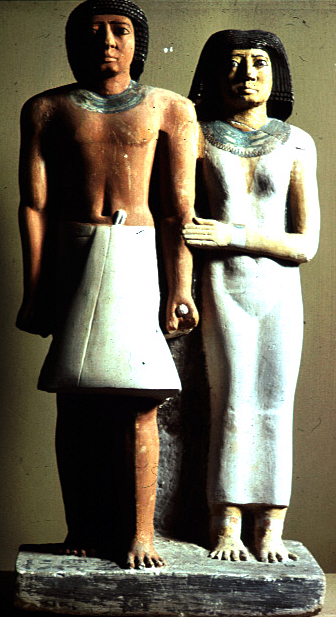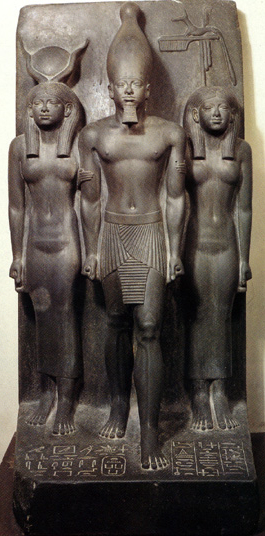|
Menkaure and His Queen
Christopher L. C. E. Witcombe
2. DESCRIPTION
Menkaure is portrayed in the familiar Egyptian pose standing as if at
attention with his left leg extended forward, his arms held stiff at his sides,
and his fists clenched holding some unidentified cylindrical objects. His
stance appears assertive, indicative of his power.
He is represented as a
mature yet vigorous man, perhaps in his thirties, with slender hips, broad
shoulders, and well-developed arms. His body has been made to appear lifelike
and, except, as is common to all Egyptian statues, in such areas as the knees,
which are over-emphasized, and the edge of the shin-bone, which is too sharp,
is anatomically correct. Overall, he appears to represent the ideal of manly
beauty in Old Kingdom Egypt.
Menkaure's face also appears to have been idealized, though its features,
which are not particularly refined or aristocratic looking, have been
particularized to the degree that it strikes us as being a portrait.
Projecting from his chin is a short transversely striped, squared-off,
wedge-shaped ceremonial beard.
On his head he wears a nemes, or
headdress, the sides of which are pulled back behind his rather large ears,
with the lappets falling to either side of his chest. The beard and the
headdress are the primary symbols of his pharaonic status. Besides the
headdress, the only other article of clothing he wears is a shendjyt
kilt which is folded across the front, with one end falling down beneath, and
held in place with a belt round his waist.
Next to Menkaure stands his queen, usually identified as Khamerernebty II (but
see The Queen’s Husband). She stands in a more naturalistic way than Menkaure with her right arm reaching around his waist and her left one bent at the elbow and holding his left arm.
She wears a long, very thin, close-fitting linen garment which covers her body almost down to her ankles and clings to her body without folds or creases. The effect would appear to be not a case of excessive static cling, or an example of the "wet-drapery" style encountered later in Ancient Greece, but intended to reveal, and describe, the forms of the queen's body.
Her breasts are outlined and the nipples indicated, as is her navel and the
slight bulge of her tummy. The material also clings in an unnatural way
around her pubic area describing a broad triangular shape with the two lower
converging sides following the slightly curving lines of her groin, and the
slightly convex but sharply drawn horizontal indicating, not a panty line (no
such thing at this early date) but presumably the upper edge of her pubic hair.
The way in which the sculptor has carefully delineated the queen's pubic area
is also found on statues of women of higher rank, such as the goddess Hathor,
as well as on statues of women of lower rank, such as the wife of Ptah-khenui
in the statue in the Museum of Fine Arts, Boston.

Ptah-khenui and his wife
Old Kingdom, Dynasty V.
2488-2400 BCE
Painted Limestone
Height 2 feet 35/8 inches (70.1 cm)
Discovered in 1936, Giza, tomb G 2004
(Museum of Fine Arts, Boston: inv. 06-1876)
This sort of treatment of
the pubic area would appear to be a convention reaching back into the
predynastic past when on fertility figurines the sexual triangle was
exaggerated into a wide triangular shape indicated by incisions and extending
across almost the whole width of the front of the body.
Her knees, like those
of Menkaure, are also exaggerated and outlined unnaturally through her dress.
The dress was probably sleeveless, with the upper edge coming just above, or
just below, the breasts and held up by wide straps. But neither the edges of
the straps at her shoulders, nor what would have appeared as a plunging neckline, are indicated, thereby making the dress seem invisible and her to seem nude even while clothed.
It must be kept in mind that, as surviving traces of
colour indicate, the statue was originally painted and that probably such lines
as the shoulder straps of the queen's dress would have been shown (although it
was actually more frequently the case that these lines would be engraved on the
actual sculpture).
Jewellery, especially necklaces, such as is seen worn by
the woman in the Ptah-khenui and his wife, would probably also have
been painted on the sculpture. In reality, such necklaces, according to
tradition already established in the prehistoric period, were composed of beads
made of bone, egg-shell, ivory, animal teeth, sea-shells and other organic
material. The many-stranded necklaces also used gold, silver, and
semi-precious jewels and cylindrical beads called wesekh and
menat.
Queen Hetepheres I, the great grandmother of Menkaure's queen,
was buried with ivory and silver bracelets decorated with butterflies of lapis
lazuli, turquoise, and carnelian. No doubt, such jewellery was as much
amuletic as decorative intended to bring the wearer good fortune and also serve as a
protection against evil.
On the queen's forehead can be seen her own hairline below what is thereby
seen to be a thick wig, probably made from human hair, tucked behind her ears
like Menkaure's nemes and worn in a tripartite manner with two locks
passing in front of the shoulders and reaching to the level of the arm-pit, and
the rest falling behind. Although the tripartite wig was also worn by women in
subordinate positions, it may have been more an indicator of maturity than of
class.
It should be noted that the statue is unfinished. Only the heads and part of
the upper part of the body have received their final polish, and clearly the
carving of the lower parts of both figures, especially the legs and feet of The
queen, was left incomplete. Moreover, the flat area next to their feet where
inscriptions identifying each figure would have been carved is blank.

Menkaure, Hathor, and Cynopolite Nome
Old Kingdom, Dynasty V.
2548-2530 BCE
Green schist (Greywacke)
3 feet 13/8 inches high
(Egyptian Museum, Cairo)
An examination of the statue of Menkaure, Hathor, and Cynopolite Nome, one of the four (and a fragment of a fifth) so-called triads of found at Menkaure's Valley Temple , makes it clear that also unfinished are Menkaure's shendjyt kilt, which lacks its pleats, and the queen's wig, which lacks the striations seen in the hair of Hathor and the accompanying personification of the Cynopolite Nome.
3. THE QUEEN'S HUSBAND
|

Menkaure and His Queen
2548-2530 BCE
4th Dynasty
Greywacke
Height: 4 feet 67/8 inches (139.5 cm)
(Museum of Fine Arts, Boston)
Copyright © (text only) 2000
Christopher L. C. E. Witcombe
All rights reserved
|

